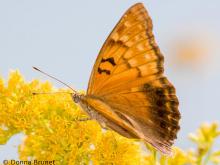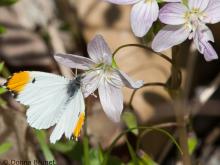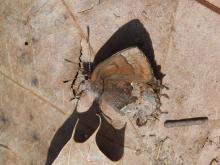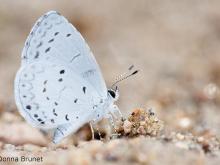Butterflies and Moths
Media

Species Types
Scientific Name
More than 700 species in North America north of Mexico
Description
Learn about butterflies and skippers as a group. What makes a butterfly a butterfly? How are they different from moths? What are the major groups of butterflies?
Media

Species Types
Scientific Name
Polygonia progne
Description
The gray comma is easy to ID if you can see the underside: it is charcoal gray with many fine dark streaks, and its comma marking is L-shaped and narrows to a fine point at each end.
Media

Species Types
Scientific Name
Polygonia comma
Description
The eastern comma is named for a small white mark on the underside of the hindwing. It flies spring through fall, and even in winter, on warm, sunny days.
Media

Species Types
Scientific Name
Asterocampa clyton
Description
The tawny emperor is less common than the hackberry emperor and has a rustier coloration. Both species feed on hackberry trees as caterpillars.
Media

Species Types
Scientific Name
Pieris rapae
Description
A common butterfly in Missouri, the cabbage white was introduced in the 1800s from Europe and became a crop pest.
Media

Species Types
Scientific Name
Pontia protodice
Description
The checkered white is named for the charcoal-colored patterns on the white wings of adults. As with the closely related cabbage white, the larvae feed on plants in the mustard family.
Media

Species Types
Scientific Name
Anthocharis midea
Description
Falcate orangetip males are unmistakable with their small size, white coloration, and orange wingtips. Look for them in open woodlands in April.
Media

Species Types
Scientific Name
Callophrys henrici (formerly Incisalia henrici)
Description
Henry’s elfin is a small brown butterfly with splendid camouflage markings. It lives in and near open woodlands. The adults fly only in April and early May, when redbuds and wild plums are blooming.
Media

Species Types
Scientific Name
Celastrina ladon
Description
The spring azure is among the first butterflies of the year. It occurs in a variety of habitats. The early spring appearance helps you identify it.
Media

Species Types
Scientific Name
Celastrina neglecta
Description
Formerly considered the same species as the spring azure, the summer azure can be identified, in large part, by the season when you see it.
See Also


Media

Species Types
Scientific Name
About 1,500 species in North America north of Mexico
Description
Adult caddisflies are mothlike. Their larvae are aquatic and build portable, protective cases out of local materials, including grains of sand, bits of leaves and twigs, and other debris.
Media

Species Types
Scientific Name
Corydalus cornutus
Description
Adult eastern dobsonflies are huge and mothlike, with large wings and a weak, fluttery flight. The fiercely predaceous aquatic larvae, called hellgrammites, are well-known to anglers, who often use them as bait.
About Butterflies and Moths in Missouri
Butterflies, skippers, and moths belong to an insect order called the Lepidoptera — the "scale-winged" insects. These living jewels have tiny, overlapping scales that cover their wings like shingles. The scales, whether muted or colorful, seem dusty if they rub off on your fingers. Many butterflies and moths are associated with particular types of food plants, which their caterpillars must eat in order to survive.





















